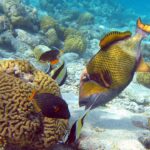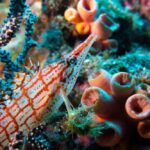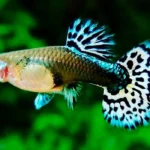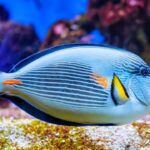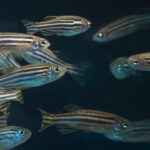Aquascaping for Beginners Picture looking into a glass box and discovering a mini underwater forest, green with plants, speckled with rocks, moving with currents, and full of life. This isn’t a fish tank—this is aquascaping for beginners.
Let’s go deep into the universe of aquascaping for beginners—step by step.
What Is Aquascaping for Beginners, Really?
It’s about making life and layout harmonious. You’re crafting a living painting. Some compare aquascaping for beginners to bonsai tree cultivation. Both need patience, foresight, and insight into how living things work themselves out over the long haul. The huge difference? In aquascaping for beginners, water is your medium.
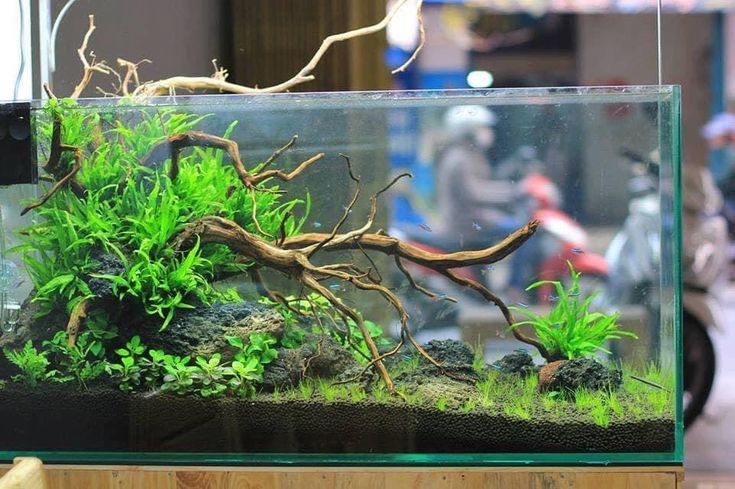
Types of Aquascaping for beginners: Styles
Before you begin, you need to know various aquascaping styles. Each has its own beauty.
Nature Aquarium (Takashi Amano Style)
Inspired by natural landscapes. Think of a grassy plain, mountain valley, or forest floor recreated underwater. Asymmetry and the “golden ratio” are often used.
Iwagumi Style
A minimalist layout that uses a small number of stones in a carefully balanced formation. Plants are usually low-growing carpets.
Dutch Style
Focuses more on plants than hardscape. It’s like a blooming garden inside your aquarium with multiple plant species arranged in tiers and textures.
Jungle Style
Less trimmed, more wild and overgrown. It embraces chaos while maintaining balance.
Biotope Style
Replicates a specific natural habitat with precise water conditions, plants, and even fish that co-exist in the wild.
Choose a style that resonates with you, particularly for your initial tank.
Planning Your Aquascape—The Blueprint
It’s planning that makes all the difference with aquascaping. Begin by asking yourself:
What’s my budget?
How much space do I have?
Do I want to include fish? Which ones?
Do I prefer plants that need low or high maintenance?
Choosing the Right Tank
For newbies, a 20–30-gallon tank is perfect. Big enough for imagination but small enough to handle.
Types of Tanks
Glass Tanks: Better clarity, more scratch-resistant.
Acrylic Tanks: Lighter, flexible, but prone to scratching.
Lighting: The Heartbeat of Aquascaping
Plants require light to photosynthesise. Weak lights = weak plant growth.
Types of Lighting
LEDs: Energy-efficient, full-spectrum, adjustable intensity.
T5 Fluorescents: Bright but generate heat.
PAR Values (Photosynthetically Active Radiation): Choose a light based on plant requirements—low-light plants need less, high-light plants like carpeting species need more.
Building the Base—Substrate and Hardscape
Substrate: Your Aquascape’s Foundation
Substrate holds plant roots, influences water chemistry, and adds visual appeal.
Types
Inert Gravel/Sand: Aesthetically pleasing but lacks nutrients.
Nutrient-Rich Substrates: Like ADA Aqua Soil, which feeds plants.
Layered Approach: Use nutrient soil at the base and cap with gravel or sand.
Hardscape Materials: Rocks and Driftwood
Hardscape is the “skeleton” of your landscape.
Popular Rocks
Seiryu Stone: Grey-blue rock with white veins.
Dragon Stone: Lightweight, holey texture.
Lava Rock: Great for attaching moss.
Popular Driftwood
Spider Wood: Twisted, web-like.
Mopani Wood: Smooth, dark, sinks quickly.
Manzanita Wood: Delicate, branching structure.
When designing, think of visual flow and focal points. Utilise natural curves and the “rule of thirds” to lead the eye.
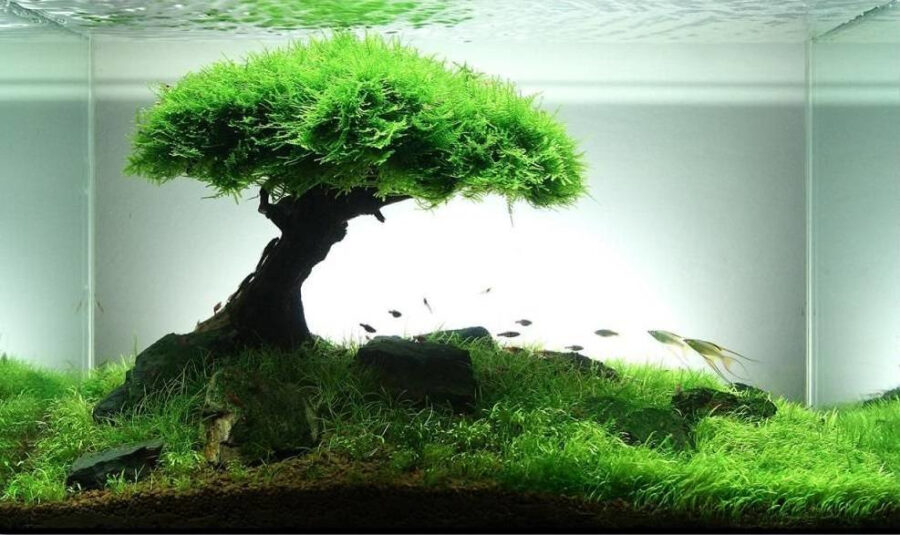
Choosing Your Plants—The Living Canvas
Plant Categories
Foreground (Carpeting Plants):
Dwarf Hairgrass
Monte Carlo
Glossostigma elatinoides
Midground:
Cryptocoryne wendtii
Anubias nana
Java Fern
Background:
Vallisneria
Rotala rotundifolia
Amazon Sword
Epiphytes (Attach to Hardscape):
Java Moss
Bucephalandra
Anubias
Planting Tips:
Use tweezers for precision.
Mist plants while arranging to keep them moist.
Don’t overcrowd; leave space for growth.
Trim long roots before planting.
The Role of CO₂ and Fertilizers
Do I Need CO₂ Injection?
Low-tech tanks (low light, easy plants): No CO₂ needed.
High-tech tanks (high light, demanding plants): CO₂ injection is a must.
Types of CO₂ Systems:
Pressurized Systems: Reliable and adjustable, but costly.
DIY Yeast Systems: Cheap, inconsistent.
Liquid Carbon (e.g., Seachem Excel): Easier but less effective.
Fertilizers (Macros and Micros):
Macronutrients (NPK): Nitrogen, Phosphorus, Potassium.
Micronutrients: Iron, Magnesium, Zinc, etc.
Dosing can be done:
Daily (EI method) for high-tech tanks.
Weekly for low-tech tanks.
Adding Life Fish and Invertebrates
Popular Fish for Aquascapes:
Neon Tetras
Ember Tetras
Rasboras
Otocinclus (great algae eaters)
Betta (for solo tanks)
Shrimp and Snails:
Amano Shrimp: Eat algae and detritus.
Cherry Shrimp: Colorful and active.
Nerite Snails: Excellent algae eaters, they won’t reproduce in freshwater.

Water Parameters and Filtration
Water Parameters to Monitor:
pH: Most aquascaping plants thrive between 6.5–7.5.
Temperature: 72°F to 78°F (22–25°C).
Ammonia/Nitrite: Should always be 0 ppm.
Nitrate: Ideally under 20 ppm.
Filtration:
A good filter:
Keeps water clear.
Provides biological filtration (beneficial bacteria).
Creates a gentle flow.
Popular Choices:
Hang-on-back (HOB): Great for small tanks.
Canister Filters: Best for larger setups.
Sponge Filters: Perfect for shrimp tanks.
Maintenance—The Art of Patience
Maintenance—Weekly Tasks:
25–50% water change
Trim plants
Clean glass
Prune dead leaves
Check CO₂ and fertilization schedule
Monthly Tasks:
Replace worn equipment (tubing, bulbs, etc.) The Art of Patience
Clean filter media (with tank water)
Reassess plant growth and replant if needed
Common Problems and How to Fix Them
Algae Outbreaks:
Cause: Imbalance in light, nutrients, or CO₂.
Fix: Reduce light hours, increase water changes, and add algae eaters.
Melting Plants:
Cause: Transplant shock or poor nutrition.
Fix: Wait it out or enrich substrate/ferts.
Cloudy Water:
Cause: Uncycled tank or dirty substrate.
Fix: Do water changes and add filter media like Purigen or activated carbon.

Conclusion
Aquascaping for beginners is half science, half soul.
Mistakes will be made. Plants will die. Algae will bloom.
To aquascaping for beginners, the learning curve can look intimidating. But all great aquascapers began where you are today: asking questions, experimenting, and sometimes failing.
Allow the process to guide you. Cherish every leaf sprouting and each pristine water change. And when at last you sit back, gaze into your aquarium, and feel pride and peace, you’ll realise why aquascaping for beginners has stolen hearts across the globe. Join us in the art of aquascaping. Your first masterpiece is just the start.
But with every mistake, you’ll become wiser. And every aquascaping for beginners will be improved upon the previous one. So what are you waiting for? The tank awaits. The water is still. Your aquascaping adventure starts today.
FAQs
Do I need CO₂ for my aquascape?
Not necessarily. With low-light, low-maintenance plants such as Anubias, Java Fern, or Cryptocoryne, you may forego CO₂. But if you’re planning for heavy growth, carpeting plants, or a “high-tech” aquascape with intense lighting, CO₂ injection is strongly advised.
What’s the best tank size for beginners?
A 20–30 gallon tank is optimal. It provides you with enough room to have fun without being too hard to work with. Smaller tanks are tempting but less tolerant of errors in water chemistry.
How long does it take to cycle a planted tank?
Normally 4–6 weeks. In this amount of time, beneficial bacteria will grow and acclimate, which makes the tank safe for fish. You can accelerate the cycle with bacterial starters or by incorporating filter media from a mature tank.
Can I do aquascaping for beginners without fish?
Yes! Some aquascapers have “plant-only” tanks, particularly when they’re working on layout and growth. But the addition of fish or shrimp brings life and motion to the tank and completes the ecosystem.
How do I prevent algae in my aquascape?
Balance is paramount. Don’t overfeed, maintain a consistent light schedule (8–10 hours/day), change water weekly, and add algae-eating shrimp or snails, if desired. If algae do grow, determine the species and make adjustments in lighting, nutrients, or CO₂.
What are the easiest plants for aquascaping for beginners?
Great beginner plants include:
Java Fern
Anubias
Amazon Sword
Cryptocoryne
Hornwort
Java Moss


